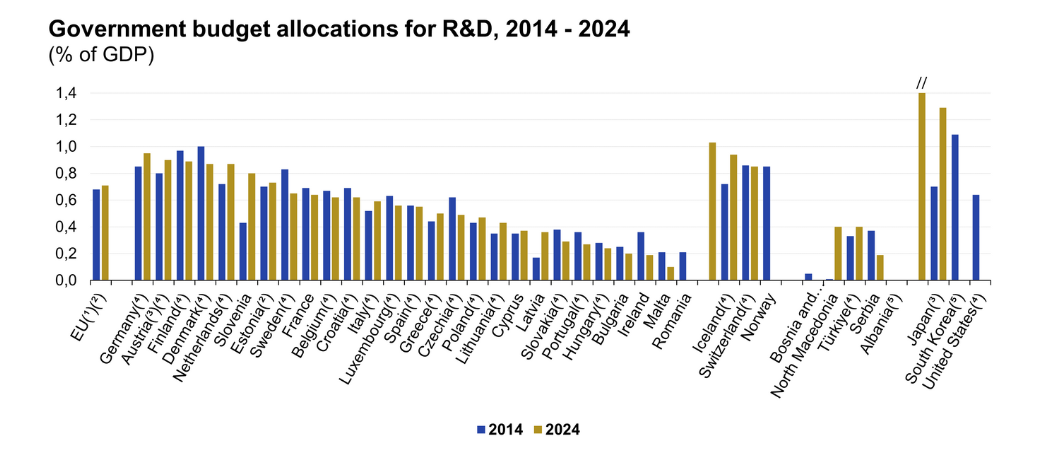Luxembourg invests most in R&D per capita, followed by Denmark and the Netherlands

Government budget allocations for R&D in 2014 and 2024 (% of GDP). Source: Eurostat
From 2014 to 2024, national budget allocations for R&D increased by 59.5% across the EU’s present members to an estimated €127,916 million, according to data from Eurostat. Year-on-year, this represents an increase of 3.4%.
Germany invests the most in R&D, with provisional budget allocations of €44,918 million in 2024, or 35% of the total EU. France, Italy and the Netherlands follow at a distance, with allocations of €18,924 million, €13,502 million and €9,737 million respectively last year.
Substantial increases over the decade can be seen in Latvia, which more than tripled its budget allocations for R&D from €38.2 million in 2014 to €147.7 million in 2024, and in Slovenia, which moved from €161.3 million to €584.7 million. Lithuania, Poland, Cyprus, Bulgaria, Estonia and Malta more than doubled their R&D budget allocations. However, in absolute terms they remain among the lowest across the EU.
Eurostat also looked at the budget allocations for R&D per person, which at the EU level rose by 57% from 2014 levels to €284.7 in 2024. That year, the highest amounts were recorded in Luxembourg with €759.2, followed by Denmark with €586.8 and the Netherlands with €542.7. At the other end of the scale were Romania at €19.1, Bulgaria at €38.3 and Hungary at €58.7.
Related articles
- EU urged to exempt research spending from deficit rules
- New Widening funding must consider relative progress, observers say
Looking at the socioeconomic objectives of the R&D supported, a large part was directed to the general advancement of knowledge, with 35.7% going to general university funds. Meanwhile, 9.4% of the budget allocations went to industrial production and technology, 7% to health, and 6.1% to the exploration and exploitation of space.
Overall, provisional budget allocations for 2024 represented 0.71% of the EU’s GDP, against 0.68% in 2014, the Eurostat data show. The figure increased for 11 EU member states, was stable for Spain and declined for the rest of the EU governments, particularly Ireland, Czechia and Denmark.
Although the provisional budget allocations refer to budget provisions and not actual expenditure, the EU still has a long way to go to reach its target of spending 3% of its GDP in R&D. As of now, it averages around 2.3%.





 A unique international forum for public research organisations and companies to connect their external engagement with strategic interests around their R&D system.
A unique international forum for public research organisations and companies to connect their external engagement with strategic interests around their R&D system.